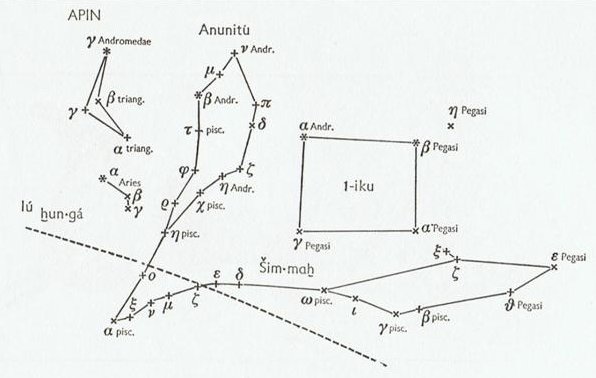When I read The Eighth Island I noticed the similarity between the name Apina on Easter Island and the name of the Babylonian constellation mulApin (the Plow):
The Polynesian language does not allow a word to end with a consonant and Babylonian Apin would therefore become Apina. However, I dismissed the possibility of a connection because of the great time gap. But now I have come to realize that my idea probably was correct. I looked up what stars constituted mulApin and in rongorongo times these stars rose heliacally beginning in April 16 with Metallah (α) and ending in April 19 with γ Andromedae (Alamak, the last star in the constellation and at her left foot):
This could explain why the first 3 glyphs on side b clearly belong in the pattern at the end of side a. "In the Babylonian star catalogues, Triangulum, together with Gamma Andromedae, formed the constellation known as MUL.APIN ... 'The Plough'. It is notable as the first constellation presented on (and giving its name to) a pair of tablets containing canonical star lists that were compiled around 1000 BC, the MUL.APIN. The Plough was the first constellation of the 'Way of Enlil' - that is, the northernmost quarter of the Sun's path, which corresponds to the 45 days on either side of summer solstice. Its first appearance in the pre-dawn sky (heliacal rising) in February marked the time to begin Spring ploughing in Mesopotamia. The Ancient Greeks called Triangulum Deltoton (Δελτωτόν), as the constellation resembled an upper-case Greek letter delta (Δ). It was transliterated by Roman writers, then later Latinized as Deltotum. Eratosthenes linked it with the Nile Delta, while the Roman writer Hyginus associated it with the triangular island of Sicily, formerly known as Trinacria due to its shape. It was also called Sicilia, because the Romans believed Ceres, patron goddess of Sicily, begged Jupiter to place the island in the heavens. Greek astronomers such as Hipparchos and Ptolemy called it Trigonon (Τρίγωνον), and later, it was Romanized as Trigonum. Other names referring to its shape include Tricuspis and Triquetrum. Alpha and Beta Trianguli were called Al Mīzān, which is Arabic for 'The Scale Beam'. In Chinese astronomy, Gamma Andromedae and neighbouring stars including Beta, Gamma and Delta Trianguli were called Teen Ta Tseang Keun (天大将军, 'Heaven's great general'), representing honour in astrology and a great general in mythology. Later, the 17th-century German celestial cartographer Johann Bayer called the constellation Triplicitas and Orbis terrarum tripertitus, for the three regions Europe, Asia, and Africa. Triangulus Septentrionalis was a name used to distinguish it from Triangulum Australe, the Southern Triangle. Polish astronomer Johannes Hevelius excised three faint stars - 6, 10 and 12 Trianguli - to form the new constellation of Triangulum Minus in his 1690 Firmamentum Sobiescianum, renaming the original as Triangulum Majus. The smaller constellation was not recognised by the International Astronomical Union (IAU) when the constellations were established in the 1920s." (Wikipedia)
Possibly Apina Iti was the name the creators of Manuscript E used for Triangulum Minus:
| ||||||||||||||||||||||||||||||||||||||||||||||||||


